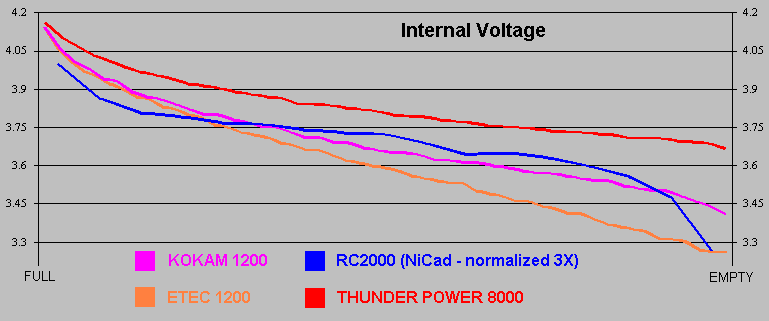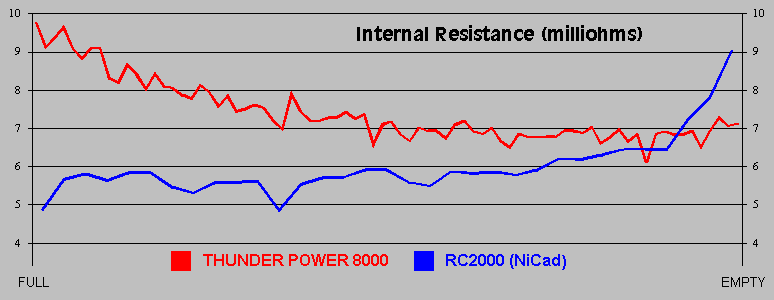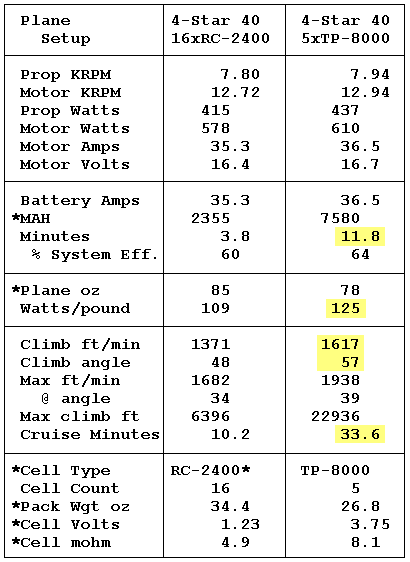
Lithium Polymer Cells

|
|
Lithium Polymer Cells
|
 What do lithium polymer (LiPo) cells have in common with electricity, water, and fire?
This is a strange way to start out talking about LiPo, but it kind of summarizes my feelings.
Electricity is clearly extremely important to our everyday lives.
Just ask the people who were without it due to hurricanes and other natural disasters.
Electricity kills many people and is responsible for the destruction of a lot of property.
The same is true for water or fire or many of our modern inventions.
Alfred Nobel probably established the Nobel Prize because of the destructive potential of dynamite.
It is clear that LiPo is revolutionizing our hobby,
but it is fair to ask if the advantages really outweigh the disadvantages at this time.
What do lithium polymer (LiPo) cells have in common with electricity, water, and fire?
This is a strange way to start out talking about LiPo, but it kind of summarizes my feelings.
Electricity is clearly extremely important to our everyday lives.
Just ask the people who were without it due to hurricanes and other natural disasters.
Electricity kills many people and is responsible for the destruction of a lot of property.
The same is true for water or fire or many of our modern inventions.
Alfred Nobel probably established the Nobel Prize because of the destructive potential of dynamite.
It is clear that LiPo is revolutionizing our hobby,
but it is fair to ask if the advantages really outweigh the disadvantages at this time.
The picture above was taken from a thread on an E-Zone Forum after the most intense burning had subsided. This was from a single cell. We are not yet where we need to be in terms of safety. We need to get there soon, not just to advance the hobby, but to prevent it from being legislated out of existence.
Enough ranting. Let's talk about using these cells. LiPo cells are generally flat, thin rectangles with delicate-looking tabs on one end. One of these tabs is aluminum with a solderable coating. Don't mess up this coating. Initially, LiPo was popular among the indoor flyers due to their light weight and low current drain. The primary limitation for larger planes was the inability of these cells to discharge at a high rate. This continues to improve with time, but LiPo use in larger planes requires multiple cells in parallel to meet current demands. The practical result is packs that are not substantially lighter, but with very high MAH capacity, and low internal resistance. These packs are also incredibly expensive. For example, my eNobler uses 20xCP1700 cells, about $90 and 7-minute flights. For LiPo I would use 2 3S4P (3 series, 4 parallel, or 12 total cells) packs for $460 and 30-minute flights. It would be great if I could pay $230 for 15-minute flights, but you need the 4P to pull the amps for hovering, etc. Also, I can charge my CP1700's in less than 20 minutes.
I have tested a number of individual cells as well as some assembled packs. Some of the cells are probably already obsolete. I had read nothing but praise for the Thunderpower packs. My testing indicates that they are superior to any of the Kokam or E-Tec cells that I tested, as well as being superior to any NiCad or NiMH pack. This sounds like an endorsement and I guess it is, tempered by the disadvantages listed above. Please note that I paid for this stuff, no freebies!
The winter building season is approaching for many. If you have a popular LiPo pack that I did not include here, I would be happy to test it if you can spare it for a week. E-mail me.
Take a look at the graph below. Each curve represents the internal voltage of a different cell. ElectriCalc uses a representative average of this curve to obtain the cell voltage number used in calculations. Note that the NiCad voltage has been scaled exactly 3 to 1. This indicates that we can consider a Lithium cell to be equivalent to three NiCads. That's a pretty helpful coincidence.

The voltage is pretty much chemistry, i.e. all NiCads and NiMH look pretty much alike, and all LiPo look pretty much alike. The real differentiator for our use is internal resistance. NiCad and NiMH manufacturers generally list this information (albeit too low values). LiPo, on the other hand, seems to come to us through vendors who obtain them from mysterious manufacturers, probably mostly Korea, and with a dearth of useful data (at least for my needs). I began testing presupposing the LiPo cells would have relatively high internal resistance. Well . .
The graph below illustrates the tests that blew me away. I have plotted the resistance of an RC2000 NiCad cell (low resistance) along with a Thunder Power 8000 "cell". This is actually the equivalent of four 2050 cells in parallel. Remember how we talked about paralleling cells to get the current we need safely? This combination weighs about the same as three CP1700 cells (remember the 3:1 ratio?), and definitely less than three RC2000 cells. If you look at the graph you can see that the LiPo resistance is maybe 40% higher than the NiCad's. So the NiCad is better, right? Wrong!!! Remember the 3:1 ratio? We need to figure three NiCads in series to compare with one LiPo. This means that the equivalent LiPo resistance is actually half of the NiCad's!!!

While we're looking at the curves, I'll point out a couple of other interesting things. As the NiCad reaches complete discharge, the resistance starts to increase quite a bit. Since the internal voltage starts to drop off at the same time, the combined effect is dramatic. This is normal for all NiCads (and NiMH). On the other hand, look what the Thunder Powers do. The resistance goes down with use! This appears to be a temperature effect rather than state-of-charge.
Testing: I normally build two end-end soldered packs when testing NiCad and NiMH cells. This tends to average out cell-to-cell variations. With LiPo I chose to buy several types of individual cells. The scientific rationale was that packs cost way too much money. On the other hand, I bought two Thunder Power packs. Main reason was that I could not get individual cells. I chose a 3S4P configuration that made a good replacement for my 10xCP1700 packs. I tested the individual cells at several different discharge rates. My purpose is to come up with an internal voltage, resistance, and MAH for use in ElectriCalc. I do not attempt to validate claims of maximum continuous or peak discharge rates. The Thunder Power cells put out close to their rated MAH capacity. The LiPos proved to really poop out at higher discharge rates. In general, the E-Tec cells were somewhat better than the Kokams. An exception was the little Kokam 340 cell, perported to be good to 20C continuous discharge. Indeed, this cell consistently put out over 300 MAH at up to 20C discharge. The other cells typically were down to 75% rated capacity at 3C. 3C is what I chose to determine MAH. This represents a 20-minute flight. Your mileage may vary. The Thunder Power cells were clearly superior to every other LiPo cell tested. Their reputation is well-deserved. They were tested ao 20 Amps, the limit of my test set.
Results: I have included individual cells as well as some parallel combinations. I included the Kokam 2070, 2670, and 3270 cells since I bought them. They are OK cells but the size is a bit large for most applications. If you want to create your own parallel combination, do the following:
L>>>>>>>>>>*V>>>*V>>>>*V>>>>*V>>>>*V>>>>*V>>>>>L>>>>>>>>>>>>>>>>>>>>>>>>>>>>>>>>
CELLS MAH mOHM DIA. HGT. WGT. MAH/OZ. COMMENTS
(typ) (in) (in) (oz)
E-Tec250 220 292.8 0.98 1.10 0.20 1094 3.70 0.19T 6C max. 3C measured
E-Tec700 650 100.8 1.34 1.89 0.53 1229 3.70 0.19T 5C max. 3C measured
E-Tec1200 1000 79.2 1.34 2.36 0.81 1233 3.70 0.24T 5C max. 3C measured
Kokam340 330 97.2 1.18 2.17 0.35 936 3.73 0.12T 20C! 3C measured
Kokam640 470 106.8 1.34 2.01 0.48 987 3.73 0.16T 8C max. 3C measured
Kokam1200 860 70.8 1.50 2.05 0.81 1060 3.73 0.24T 5C max. 3C measured
Kokam2070 1400 39.6 2.52 3.74 1.55 902 3.72 0.15T 3C max. 3C measured
Kokam2670 1200 42.0 2.52 3.74 1.55 630 3.72 0.18T 3C max. 3C measured
Kokam3270 2000 20.4 2.52 3.74 2.26 886 3.72 0.21T 3C max. 3C measured
TP-2050 1895 32.4 1.97 2.44 1.34 1414 3.75 0.24T 5C max. extrapolated (Thunder Power)
TP-7800 7260 10.2 1.97 2.44 5.36 1354 3.75 1.10T 5C max. 2.5C measured (Thunder Power)
TP-8000 7580 8.1 1.97 2.44 5.36 1414 3.75 1.10T 5C max. 2.5C measured (Thunder Power)
2xE-Tec1200 2000 39.6 1.34 2.36 1.62 1233 3.70 0.48T 5C max. extrapolated
2xKokam340 660 48.6 1.18 2.17 0.70 936 3.73 0.24T 20C! extrapolated
2xKokam1200 1720 35.4 1.50 2.05 1.62 1060 3.73 0.48T 5C max. extrapolated


|